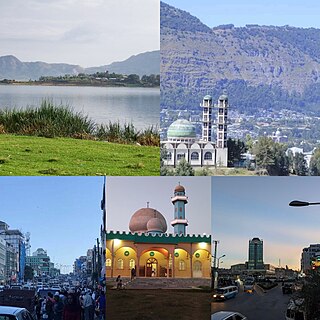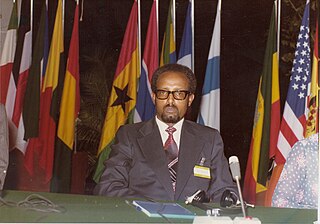At the end of each Major League Baseball season, the league leaders of various statistical categories are announced. Leading either the American League or the National League in a particular category is referred to as a title.

Adwa is a town and separate woreda in Tigray Region, Ethiopia. It is best known as the community closest to the site of the 1896 Battle of Adwa, in which Ethiopian soldiers defeated Italian troops, thus being one of the few African nations to thwart European colonialism. Located in the Central Zone of the Tigray Region, Adwa has a longitude and latitude of 14°10′N38°54′E, and an elevation of 1907 meters. Adwa is surrounded by Adwa woreda.
Tekle Haymanot II, throne name: Admas Sagad III was Emperor of Ethiopia from 18 October 1769 to 13 April 1777, and a member of the Solomonic dynasty. He was the son of Yohannes II by Woizero Sancheviyar, at the Imperial prison of Mount Wehni.

Tekle Giyorgis I, throne name Feqr Sagad, was Emperor of Ethiopia intermittently between 20 July 1779 and June 1800, and a member of the Solomonic dynasty. He was the youngest son of Yohannes II and Woizoro Sancheviyer, and the brother of Tekle Haymanot II.
Hezqeyas was Emperor of Ethiopia from 26 July 1789 to January 1794, and a member of the Solomonic dynasty. He was the son of Iyasu III.
Baeda Maryam II was Emperor of Ethiopia from 15 April to December 1795. He may have been the son of Salomon II. Although E. A. Wallis Budge, in his book A History of Ethiopia: Nubia and Abyssinia, notes some authorities believe Baeda Maryam was the same person as Salomon III, Nathaniel Pearce, who met the former Emperor when he visited Ras Wolde Selassie 20 January 1813, states that he had been Emperor only once, for nine months.
Salomon III was Emperor of Ethiopia intermittently between 1796 and 1797, and a member of the Solomonic dynasty. He was the son of Tekle Haymanot II. He may be identical with the Emperor Solomon whom the traveler Henry Salt lists as one of the Emperors still alive at the time of his visit in 1809/1810. E. A. Wallis Budge notes some authorities believe he was the same person as Baeda Maryam II.
Yonas was Emperor of Ethiopia from 18 August 1797 to 4 January 1798, and a member of Solomonic dynasty. He was the son of Letezum, and the grandson of the Emperor Fasilides.

Dessie is a town in north-central Ethiopia. Located in the South Wollo Zone of the Amhara Region, it sits at a latitude and longitude of 11°8′N39°38′E, with an elevation between 2,470 and 2,550 metres above sea level. Dessie is 400 km to the north of the capital Addis Ababa. It has a population of more than 200,000 people in over 30 wards.
Ali I of Yejju was Ras of Begemder, and following the death of Ras Mikael Sehul, Regent of the Emperor of Ethiopia. He was the son of Abba Seru Gwangul, chieftain of the Yejju, and Woizero Gelebu Faris, daughter of Ras Faris of Lasta.

Mikael Sehul was a nobleman who ruled Ethiopia for a period of 25 years as regent of a series of emperors. He was also a Ras or governor of Tigray 1748–71 and again from 1772 until his death. He was a major political figure during the reign of Emperor Iyasu II and his successors until almost the time of his death.
Tekle Wolde Hawaryat was an Ethiopian politician. Anthony Mockler describes him as "the only contemporary of Haile Selassie who throughout a long life was always prepared to come out in open opposition to him."

The Ministry of Foreign Affairs is the Ethiopian government ministry which oversees the foreign relations of Ethiopia.
Enderta or Inderta is a former historical province of Ethiopia; it is located in the eastern edge of the Tigray highlands. Enderta is bordered on the west by Tembien, on the south and southwest by Lasta and Wag, on the east by denkel, and on the north by Agame and Adwa. Mekelle was formerly the capital of the province. Enderta's local administration of Denkel/Afar up to the edges of Aseb under its jurisdiction seems to have been highly, interlinked with the operation of the salt trade and its taxation system; the entire tasks of salt caravan organization being the responsibility of the bäalgada, title assumed by the governor of Endärta, since at least the Medieval period.
Hailu Tekle Haymanot, also named Hailu II of Gojjam, was an army commander and a member of the nobility of the Ethiopian Empire. He represented a provincial ruling elite who were often at odds with the Ethiopian central government. Hailu Tekle Haymanot was an independent-minded potentate who, throughout his life, was mistrustful of and mistrusted by the Emperor.

Teferra Wolde-Semait was an Ethiopian economist who has served as Ministry of Finance and Economic Development, and chairman of the board of the National Bank of Ethiopia from 1977 to 1982.

LijSeifu Mikael was an Ethiopian noble, member of the Solomonic dynasty, belonging to the aristocratic Amhara family from Ankober Shewa. He was the grandson of Dejazmatch Mekuria Tesfaye of Menz, a prominent general, a cousin of Emperor Menelik II of Ethiopia, and grandson of King Sahle Selassie of Shewa. Lij Seifu, a public figure, was educated in Paris at the Sorbonne. He was one of the first few earlier members of the royalty who started paying salaries to their household servants advocating freedom of slaves and an avid supporter of Ras Tafari in his bid to become an emperor of Ethiopia. He served as Ethiopia's minister to France and Germany while he lived in Europe in the 1910s, Ethiopia's Consul General to Eritrea from 1921 to 1925 and Governor of several districts till the eve of the fascist invasion of Ethiopia.

During the Second Italo-Ethiopian War, the Italians captured and either imprisoned as prisoners of war or executed selected prominent Ethiopians. The majority of the public executions and mass incarcerations happened in the wake of the assassination attempt on Rodolfo Graziani. The Italian occupying force gave permission to the black shirts to murder educated Ethiopians, sparing only a few notables who were transported to various concentration camps maintained in the Harar region, Italian Somaliland, Eritrea and Italy. While the majority of prisoners who were kept at Asinara and other camps in Italy survived, tens of thousands of detainees perished under the severe conditions they were forced to live in. According to famous survivors like Ambassador Imru Zeleke, conditions were worse in Italian Somaliland camps due to the scarcity of food, water and medicine. According to Imru Zeleke, tens of thousands of Ethiopians died every year.
Haile Maryam Gebre of Semien, Horse name: Abba Dammana was an early 19th century governor of Semien, Welkait and Wogera. Haile Maryam tried to hold his hereditary possessions in the face of continuous pressure from rival lords during Ethiopia's Zemene Mesafint era. He is remembered as the guardian of Waldeba monastery.
Gebre Tasfa better known as Gebre of Semien was the governor of Semien, Tsegede, Welkait and Wogera during the late 18th and early 19th century in Ethiopia. He held the title of Ras, and had an unusually long reign spanning 44 years during the tumultuous Zemene Mesafint when lords of each province and district continuously fought each other for supremacy. Ras Gebre was the primary backer of his son-in-law Emperor Tekle Giyorgis I claims to the throne.









